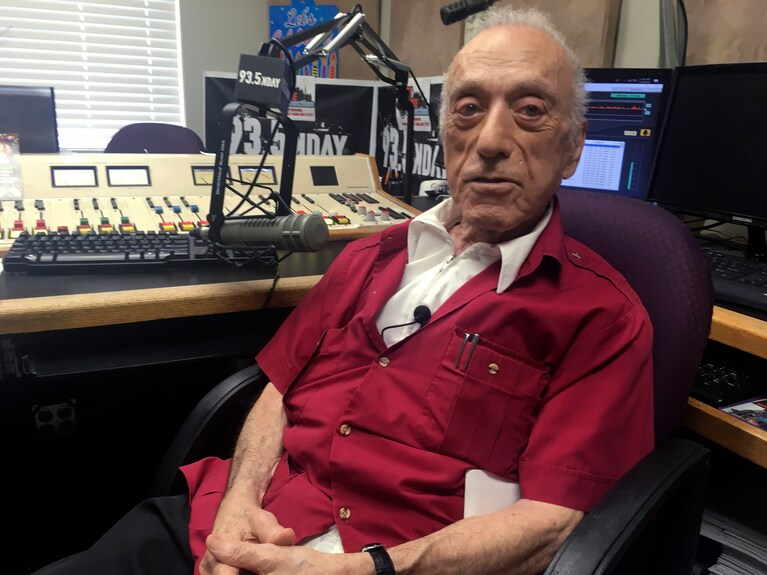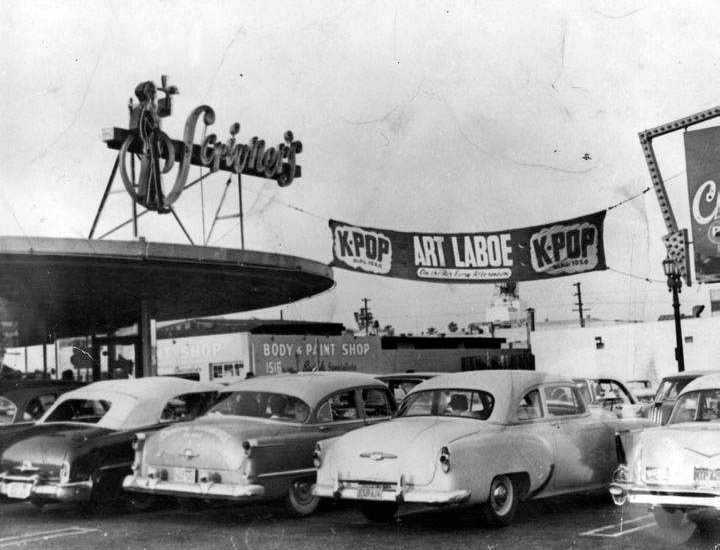Bulletin: Art Laboe has died
(Updated October 11 to include comments from Mike Wagner.)
Art Laboe in 2018 (Russell Contreras for the Asociated Press)
The Los Angeles disc jockey who coined the phrase “Oldies But Goodies” is gone. Art Laboe died last Friday at the age of 97.
“If you think of the day you first listened to Art Laboe, you realized he sounded the same many years later,” said Don Barrett of LARadio.com. “Art was so consistent, you heard him dedicate a song from a gang member in prison to his girlfriend just as gracefully as he was breaking a new record.”
As a young man, Laboe tinkered with all things electrical, eventually building his own unlicensed amateur radio setup. “Before World War II, the government was really monitoring the airwaves,” said Laboe. “These two (FCC) guys came to my house and busted me for this Ham Radio rig I had...I played music. They scared the bejesus out of me. They told me I could go to jail for five years and be faced with a $10,000 fine.” The FCC guys noticed and “kinda liked (my) good looking sister,” so they told Laboe to take down his antenna and they would "let it go, but they told me to get a license." Laboe would get his amateur radio license at the age of 14 before eventually procuring both a first and second class radio licenses.
As a teen ham radio operator
Having those broadcasting licenses proved advantageous when Laboe considered joining the military, after graduating from George Washington High School and briefly attending Stanford University. He first studied radar with the Army Signal Corps, but soon left when he learned signal corpsman were often sent first to the South Pacific to lay down wire for military communication. “The Japanese were sitting in the hills watching...I heard the casualty rate was 85% and I thought it was a little high.” Because he was not yet 18, he was able to leave the Army, switching over to the Navy. He became a radio officer with the Pan American Clipper fleet, stationed at Treasure Island in San Francisco and flying 147 times to Hawaii “carrying blood and important people.”
Art Laboe on the air at KPMO, circa 1945. (Courtesy Art Laboe / KQED)
Laboe told LARadio.com he looked for his first radio job at KSAN, then a 500 watt AM station in the Bay Area. The general manager told Laboe he had a squeaky voice and was too young to be on the radio. Recalled Laboe:
I kicked the ground and started to walk away. And then (the GM) says, "Besides, you have to have an FCC license. We need at least a 3rd Class license. We’re a combo station." I walked back and pulled out of my jacket pocket these certificates and said, "You mean one of these?'" I laid out a First Phone, 2nd Telephone and a Ham license. He looked up at me and said, "You’re hired." He put his arm around me and said, come with me. He took me to a room with three huge transmitter boxes and asked me if I could tune one of these things. I told him I thought so.
It turns out all of KSAN’s engineers were drafted into the war. KSAN had been operating illegally until Laboe got hired. “That First Class license got me my first job in radio,” he recalled.
He returned to Los Angeles in the 1950s, working at KGFJ, KFWB, and KXLA before he landed at KPOP. As rock ‘n’ Roll was on the rise, Laboe became a major promoter of the new music genre, broadcasting his show live from Scrivner's Drive-In on Sunset and Cahuenga Boulevards. Already a popular teen hangout, the drive-in was jammed every night as he declared “hey mothers, gather up your daughters. Here comes Art Laboe and his devil music!”
Laboe hosting at El Monte Legion Stadium (kcet.org)
He hosted dance shows in Los Angeles until LA County cracked down on such gatherings since many attendees were under 18 years of age amidst rising racial tensions. Laboe moved his dance shows to the nearby El Monte Legion Stadium, later memorialized by Laboe’s 1994 oldies compilation album “Memories of El Monte,” the hit title song being performed by the Penguins, featuring Frank Zappa and Ray Collins back in 1962. Thousands of teens gathered to listen and dance to all of the famous R&B and doo-wop performers of the day, including Ritchie Valens, Rosie & the Originals and the aforementioned Penguins. Laboe would greet teenagers with 50-cent pieces if they couldn’t cover the cost of admission.
Paul Rodriguez (935kday.com)
Many credit Laboe for helping easing racial segregation among teenagers and young adults in Southern California. His shows attracted White fans from the Westside, Black teens from South L.A. and Eastside Latino fans. Soldiers on weekend leaves stationed in Southern California traveled to the shows and dances throughout the 1950s. His core audience was Latino, but he had a multicultural fan base throughout his career. In 2009, the Los Angeles Times quoted comedian and one-time KKBT morning man Paul Rodriguez, who described Laboe as “more Chicano than some Chicanos…And everyone from the toughest vato to the wimpiest guy would say the same.”
Laboe noticed during his Scrivner’s Drive-In shows that many of the requests he received were not for the current hits but for songs five or more years old. It inspired him to create the first “Oldies but Goodies” compilation album in 1959, which stayed in the Billboard Top 100 for three years. He copyrighted the moniker, then proceeded to release a total of 15 volumes of oldies collections through 1985. The albums featured hits such as “Runaround Sue” by Dion, “Show & Tell” by Al Wilson, “Chapel of Love” by the Dixie Cups, “When Will I be Loved” by the Everly Brothers, among many others. Perhaps the most famous of the songs featured on his albums is first found on Volume 3, “Angel Baby” by Rosie and the Originals, and subsequently re-released in other volumes.
Laboe was heard on KDAY, KPPC, and XPRS before he spent five years at then-oldies K-EARTH 101 (KRTH) in the early 70s. Mike Wagner, program director of KRLA during the mid-80s, had Laboe in his lineup, but said Laboe should receive credit for earlier helping to stabilize and grow the station.
"KRLA operated without a license for decades...Art came along in the mid-70s and convinced the FCC that he could operate the station more profitably until a license applicant could be determined," recalled Wagner. "Art, Mr. 'Oldies But Goodies,' created his 'Hit Radio 11, from Elvis to Elton' format, mixing a wide range of oldies with a select number of current hits." Eventually KRLA was purchased by an investment group including Bob Hope and Art Linkletter, who were primarily interested in the land where the towers were built in Pasadena.
Wagner, then at KIIS-FM, watched Laboe take a supposedly dead AM station to "the top of the ratings...It was Art's voice and longtime KRLA Johnny Hayes who hosted the 24 hour programming, with Art doing the Request & Dedication Show live evenings from 7 to midnight." Wagner credits Laboe at making KRLA a valuable property. When Greater Media, who had earlier acquired "K-Hits 97" (KHTZ), wanted an AM property to compliment their FM station, "and made Hope / Linkletter an offer of $20 million without the transmitter site!"
When Wagner created his "the music and the DJs you grew up listening to," he hired Laboe along with "Emperor" Bob Hudson, Hayes, and The Real Don Steele.
"Art knew his music and knew how to connect with LA's increasing Hispanic audience before anyone else even paid attention to him...the 'Heart and Soul of Rock 'n' Roll' (that followed) was a later format that came after Hit Radio 11 and right at the ownership transition (in the 1908s). But Art's true success was HIT RADIO 11," said Wagner.
Laboe was later heard on Mega 100 (KCMG) / Mega 92.3 (KHHT) and KDAY for the next two decades, playing the oldies, offering dedications, and blowing kisses to his loyal listeners. He moved from Hollywood Hills where he ran his record label, Original Sound, to Palm Springs in 2015.
He received his star on the Hollywood Walk of Fame in 1981. A collection of Laboe’s memorabilia is currently housed at the Museum of Rock and Roll in Cleveland, Ohio. Barrett selected Laboe to receive the LARadio.com lifetime achievement award in 2010. He booked a hotel ballroom in North Hollywood for the ceremony. “We were sold out in minutes,” recalled Barrett. “It was such an honor to be able to present him with this award.”
Laboe reportedly died last Friday, October 7. Before he passed, he recorded his final show last week, "The Art Laboe Connection Show," which was heard on KDAY this past Sunday.
















One of the legends. Glad I was able to shake his hand.
ReplyDelete